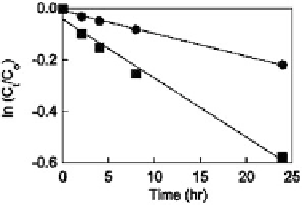Geoscience Reference
In-Depth Information
Fig. 16.17 Representative plot of the behavior of sulfa drugs obtained from photolysis on a
turntable apparatus, under four Pyrex-filtered 175-W medium-pressure Hg-vapor lamps.
Photodegradation of sulfamethazine in deionized H
2
O(filled circle) and enhanced photodegra-
dation in natural lake water (filled square box). Reprinted with permission from Boreen et al.
(
2005
). Copyright 2005 American Chemical Society
In general, photodegradation of adsorbed PAHs occurs mainly through single,
oxygen-mediated pathways or a radical intermediate mechanism. In the experi-
ment of Fioressi and Arce (
2005
), samples of BeP in solution or adsorbed on silica
gel or alumina surfaces were irradiated with a 1,000 W Xe (Hg) lamp; a glass filter
was used to isolate the wavelength range between 250 and 359 nm. Irradiation of
BeP adsorbed on silica gel and alumina surfaces, exposed to air, led to a decrease
in intensity of absorption and of emission bands, thus demonstrating its photo-
degradation. The process followed a first-order kinetic, with an apparent rate
constant of 0.173 min
-1
for BeP adsorbed on silica, and of 0.089 min
-1
for BeP
adsorbed on alumina.
The effects of surface nature and loading on the photodegradation rate of BeP
adsorbed on silica and alumina are shown in Fig.
16.18
. The type of adsorbent
affects the rate of BeP photodegradation. On silica gel, the rate is approximately
two times greater than that on an alumina surface after 12 h of irradiation. Dif-
ferences between photodegradation of BeP in solution and adsorbed on particu-
lates are clearly reflected in the degradation product. Diones, diols, and hydroxyl
derivates were identified as the major photoproducts of irradiated BeP adsorbed on
particulates. The distribution of photoproducts for samples of BeP adsorbed on
alumina was, however, different from that for silica gel under similar surface
loading. The photodegradation rate also was affected significantly by an increase
in subsurface loading and a decrease in BeP loading (Fioressi and Arce
2005
).
Irradiation of BeP in hexane solution did not lead to the formation of the major
derivates produced on adsorbed phases. This result suggests that BeP in nonpolar
solvents photodegrades through a different reaction pathway than when adsorbed
on surfaces. The type of solvent may affect, on the other hand, BeP photodegra-
dation. In acetonitrile, for example, the photodegradation rate is faster than in
hexane, and dione has been detected as one of the products.
Decabromodiphenyl ether (BDE-209) is a major industrial product from the
polybrominated diphenyl ethers used as flame retardants; derivatives of this product

